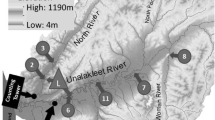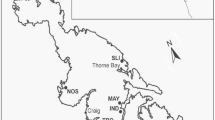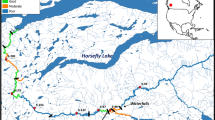Abstract
We tested the hypothesis that the carcasses of anadromous Pacific salmon (Oncorhynchus spp.) constitute a significant source of nutrients in the nutrient-poor freshwaters where these fish migrate, spawn, senesce, and die. In a 110 m-long stream reach in Southeast Alaska, we retained nearly 3000 salmon carcasses and compared streamwater nitrogen (N), phosphorus (P), and the biomass of benthic biofilm in this reach with an upstream reference reach. The study spanned 5 months, bracketed the entire salmon run, and encompassed significant seasonal variation in abiotic stream conditions. Concentrations of dissolved and particulate N and P followed distinctly unimodal patterns through time, which tracked the abundance of live salmon, and we observed strong predictive relationships between live-salmon abundance and streamwater-nutrient concentrations. In contrast, we did not observe clear relationships between salmon carcasses and streamwater nutrients. Biofilm biomass within our study reaches seemed to more closely track the abundance of live salmon than the abundance of carcasses. The experimental retention of carcasses had a minor or undetectable influence on nutrient concentrations and biofilm within the study reach as compared to the reference reach. We conclude that physical factors such as temperature, discharge, nutrient limitation, and irradiance vary seasonally in ways that maximize the influence of nutrients provisioned by live salmon and minimize the influence of carcass-derived nutrients on the aspects of stream ecosystems that we examined. Overall, our results promote a new perspective on the ecological role of salmon in freshwaters, and contribute to a more mechanistic understanding of how migratory fishes can influence aquatic ecosystems.






Similar content being viewed by others
References
Adams LG, Farley SD, Stricker CA, Demma DJ, Roffler GH, Miller DC, Rye RO. 2010. Are inland wolf–ungulate systems influenced by marine subsidies of Pacific salmon? Ecol Appl 20(1):251–62.
APHA. 1999. Standard methods for the examination of water and waste water. 20th edn. Washington, DC: American Public Health Association.
Augerot X. 2005. Atlas of Pacific salmon: the first map-based status assessment of salmon in the North Pacific. Berkeley: University of California Press. 161 pp.
Bilby RE, Ward JW. 1991. Characteristics and function of large woody debris in streams draining old-growth, clear-cut, and 2nd-growth forests in southwestern Washington. Can J Fish Aquat Sci 48(12):2499–508.
Bryant MD. 1980. Evolution of large organic debris after timber harvest: Maybeso Creek, 1949-1980. USFS General Technical Report PNW 101.
Cak AD, Chaloner DT, Lamberti GA. 2008. Effects of spawning salmon on dissolved nutrients and epilithon in coupled stream-estuary systems of southeastern Alaska. Aquat Sci 70(2):169–78.
Campbell EY, Merritt RW, Hudson J, Benbow ME, Tiegs SD, Lamberti GA. 2011. Timber harvest intensifies effects of spawning-salmon disturbance on macroinvertebrates in Southeast Alaskan streams. J North Am Benthol Soc 30:49–59.
Cederholm CJ, Peterson NP. 1985. The retention of coho salmon (Oncorhynchus kisutch) carcasses by organic debris in small streams. Can J Fish Aquat Sci 42(6):1222–5.
Cederholm CJ, Kunze MD, Murota T, Sibatani A. 1999. Pacific salmon carcasses: essential contributions of nutrients and energy for aquatic and terrestrial ecosystems. Fisheries 24(10):6–15.
Chaloner DT, Wipfli MS. 2002. Influence of decomposing pacific salmon carcasses on macroinvertebrate growth and standing stock in southeastern Alaska streams. J North Am Benthol Soc 21(3):430–42.
Chaloner DT, Martin KM, Wipfli MS, Ostrom PH, Lamberti GA. 2002. Marine carbon and nitrogen in southeastern Alaska stream food webs: evidence from artificial and natural streams. Can J Fish Aquat Sci 59(8):1257–65.
Chaloner DT, Lamberti GA, Cak AD, Blair NL, Edwards RT. 2007. Inter-annual variation in responses of water chemistry and epilithon to Pacific salmon spawners in an Alaskan stream. Freshw Biol 52(3):478–90.
Claeson SM, Li JL, Compton JE, Bisson PA. 2006. Response of nutrients, biofilm, and benthic insects to salmon carcass addition. Can J Fish Aquat Sci 63(6):1230–41.
Compton JE, Andersen CP, Phillips DL, Brooks JR, Johnson MG, Church MR, Hogsett WE, Cairns MA, Rygiewicz PT, McComb BC et al. 2006. Ecological and water quality consequences of nutrient addition for salmon restoration in the Pacific Northwest. Front Ecol Environ 4(1):18–26.
Entrekin SA, Tank JL, Rosi-Marshall EJ, Hoellein TJ, Lamberti GA. 2008. Responses in organic matter accumulation and processing to an experimental wood addition in three headwater streams. Freshw Biol 53(8):1642–57.
Fellman JB, Hood E, Edwards RT, D’Amore DV. 2008. Return of salmon-derived nutrients from the riparian zone to the stream during a storm in southeastern Alaska. Ecosystems 11(4):537–44.
Flecker AS, McIntyre PB, Moore JW, Anderson JT, Taylor BW, Hall RO. 2010. Migratory fishes as material and process subsidies in riverine ecosystems. Am Fish Soc Symp 73:559–92.
Gende SM, Quinn TP. 2006. The fish and the forest. Sci Am 295(2):84–9.
Gende SM, Edwards RT, Willson MF, Wipfli MS. 2002. Pacific salmon in aquatic and terrestrial ecosystems. Bioscience 52(10):917–28.
Gende SM, Quinn TP, Willson MF, Heintz R, Scott TM. 2004. Magnitude and fate of salmon-derived nutrients and energy in a coastal stream ecosystem. J Freshw Ecol 19(1):149–60.
Greenwood JL, Rosemond AD, Wallace JB, Cross WF, Weyers HS. 2007. Nutrients stimulate leaf breakdown rates and detritivore biomass: bottom-up effects via heterotrophic pathways. Oecologia 151(4):637–49.
Gresh T, Lichatowich J, Schoonmaker P. 2000. An estimation of historic and current levels of salmon production in the northeast Pacific ecosystem: evidence of a nutrient deficit in the freshwater systems of the Pacific Northwest. Fisheries 25(1):15–21.
Harvey BC, Wilzbach MA. 2010. Carcass addition does not enhance juvenile salmonid biomass, growth, or retention in six northwestern California streams. North Am J Fish Manag 30:1445–51.
Helfield JM, Naiman RJ. 2006. Keystone interactions: salmon and bear in riparian forests of Alaska. Ecosystems 9(2):167–80.
Holtgrieve GW, Schindler DE, Gowell CP, Ruff CP, Lisi PJ. 2010. Stream geomorphology regulates the effects on periphyton of ecosystem engineering and nutrient enrichment by Pacific salmon. Freshw Biol 55(12):2598–611.
Janetski DJ, Chaloner DT, Tiegs SD, Lamberti GA. 2009. Pacific salmon effects on stream ecosystems: a quantitative synthesis. Oecologia 159(3):583–95.
Johnson LT, Tank JL, Dodds WK. 2009. The influence of land use on stream biofilm nutrient limitation across eight North American ecoregions. Can J Fish Aquat Sci 66(7):1081–94.
Lamberti GA, Gregory SV. 2006. CPOM transport, retention and measurement. In Hauer FR, Lamberti GA, Eds. Methods in stream ecology. San Diego: Academic Press. 877 pp.
Lessard JL, Merritt RW, Berg MB. 2009. Investigating the effect of marine-derived nutrients from spawning salmon on macroinvertebrate secondary production in Southeast Alaskan streams. J North Am Benthol Soc 28(3):683–93.
Lytle DA, Poff NL. 2004. Adaptation to natural flow regimes. Trends Ecol Evol 19:94–100.
MacAvoy SE, Garman GC, Macko SA. 2009. Anadromous fish as marine nutrient vectors. Fish Bull 107(2):165–74.
Maron JL, Estes JA, Croll DA, Danner EM, Elmendorf SC, Buckelew SL. 2006. An introduced predator alters Aleutian island plant communities by thwarting nutrient subsidies. Ecol Monogr 76(1):3–24.
McIntyre PB, Jones LE, Flecker AS, Vanni MJ. 2007. Fish extinctions alter nutrient recycling in tropical freshwaters. Proc Natl Acad Sci USA 104(11):4461–6.
Minakawa N, Gara RI. 2005. Spatial and temporal distribution of coho salmon carcasses in a stream in the Pacific Northwest, USA. Hydrobiologia 539:163–6.
Mitchell NL, Lamberti GA. 2005. Responses in dissolved nutrients and epilithon abundance to spawning salmon in Southeast Alaska streams. Limnol Oceanogr 50(1):217–27.
Moore JW, Schindler DE. 2008. Biotic disturbance and benthic community dynamics in salmon-bearing streams. J Anim Ecol 77:275–84.
Moore JW, Schindler DE. 2010. Spawning salmon and the phenology of emergence in stream insects. Proc R Soc B 277:1695–703.
Moore JW, Schindler DE, Carter JL, Fox J, Griffiths J, Holtgrieve GW. 2007. Biotic control of stream fluxes: spawning salmon drive nutrient and matter export. Ecology 88(5):1278–91.
Naiman RJ, Bilby RE, Schindler DE, Helfield JM. 2002. Pacific salmon, nutrients, and the dynamics of freshwater and riparian ecosystems. Ecosystems 5(4):399–417.
Peterson M, Matthews R. 2009. Retention of salmon-derived N and P by bryophytes and microbiota in mesocosm streams. J North Am Benthol Soc 28(2):352–9.
Polis G, Power ME, Huxel GH. 2004. Food webs at the landscape level. Chicago, IL: University of Chicago Press.
Post DM, Walters AW. 2009. Nutrient excretion rates of anadromous alewives during their spawning migration. Trans Am Fish Soc 138(2):264–8.
Quinn T. 2005. The behavior and ecology of Pacific salmon and trout. Seattle: University of Washington Press. 320 pp.
Reeves GH, Everest FH, Sedell JR. 1993. Diversity of juvenile anadromous salmonid assemblages in coastal Oregon basins with different levels of timber harvest. Trans Am Fish Soc 122(3):309–17.
Rüegg J, Tiegs SD, Chaloner DT, Levi PS, Tank JL, Lamberti GA. 2011. Salmon subsidies alleviate nutrient limitation of benthic biofilms in southeast Alaska streams. Can J Fish Aquat Sci 68:277–87.
Sartory DP, Grobbelaar JU. 1984. Extraction of chlorophyll a from freshwater phytoplankton for spectrophotometric analysis. Hydrobiologia 114:177–87.
Schindler DE, Eby LA. 1997. Stoichiometry of fishes and their prey: implications for nutrient recycling. Ecology 78(6):1816–31.
Schindler DE, Scheuerell MD, Moore JW, Gende SM, Francis TB, Palen WJ. 2003. Pacific salmon and the ecology of coastal ecosystems. Front Ecol Environ 1(1):31–7.
Shaff CD, Compton JE. 2009. Differential incorporation of natural spawners vs. artificially planted salmon carcasses in a stream food web: evidence from delta N-15 of juvenile coho salmon. Fisheries 34(2):62.
Solorzano L. 1969. Determination of ammonia in natural waters by the phenolhypochlorite method. Limnol Oceanogr 14:799–801.
Stainton MP, Capel MJ, Armstrong FAJ. 1977. The chemical analysis of fresh-water. Miscellaneous Special Publication 25. Winnipeg, Canada: Freshwater Institute.
Steinman AD, Lamberti GA, Leavitt PR. 2006. Biomass and pigments of benthic algae. In: Hauer FR, Lamberti GA, Eds. Methods in stream ecology. San Diego: Academic Press. 877 pp.
Stewart-Oaten A. 2003. On rejection rates of paired intervention analysis: comment. Ecology 84(10):2795–9.
Stockner JG, Ed. 2003. Nutrients in salmonid ecosystems: sustaining production and biodiversity. Bethesda: American Fisheries Society. 302 pp.
Stockner JG, Rydin E, Hyenstrand P. 2000. Cultural oligotrophication: causes and consequences for fisheries resources. Fisheries 25(5):7–14.
Tank JL, Dodds WK. 2003. Nutrient limitation of epilithic and epixylic biofilms in ten north American streams. Freshw Biol 48(6):1031–49.
Taylor BW, Flecker AS, Hall RO Jr. 2006. Loss of a harvested fish species disrupts carbon flow in a diverse tropical river. Science 313(5788):833–6.
Tiegs SD, Chaloner DT, Levi P, Rüegg J, Tank JL, Lamberti GA. 2008a. Timber harvest transforms ecological roles of salmon in Southeast Alaska rain forest streams. Ecol Appl 18(1):4–11.
Tiegs SD, Peter FD, Robinson CT, Uehlinger U, Gessner MO. 2008b. Leaf decomposition and invertebrate colonization response to manipulated litter quantity in streams. J North Am Benthol Soc 27:321–31.
Tiegs SD, Campbell EY, Levi PS, Rüegg J, Benbow ME, Chaloner DT, Merritt RW, Tank JL, Lamberti GA. 2009. Separating physical disturbance and nutrient enrichment caused by Pacific salmon in stream ecosystems. Freshw Biol 54(9):1864–75.
Vanni MJ. 2002. Nutrient cycling by animals in freshwater ecosystems. Annu Rev Ecol Syst 33:341–70.
Verspoor JJ, Braun DC, Reynolds JD. 2010. Quantitative links between Pacific salmon and stream periphyton. Ecosystems 13(7):1020–34.
Webster JR, Covich AP, Tank JL, Crockett TV. 1994. Retention of coarse particles in streams in the southern Appalachian Mountains. J North Am Benthol Soc 13:140–50.
Winder M, Schindler DE, Moore JW, Johnson SP, Palen WJ. 2005. Do bears facilitate transfer of salmon resources to aquatic macroinvertebrates? Can J Fish Aquat Sci 62(10):2285–93.
Wipfli MS, Hudson JP, Caouette JP, Chaloner DT. 2003. Marine subsidies in freshwater ecosystems: salmon carcasses increase the growth rates of stream-resident salmonids. Trans Am Fish Soc 132(2):371–81.
Woolsey S, Capelli F, Gonser T, Hoehn E, Hostmann M, Junker B, Paetzold A, Roulier C, Schweizer S, Tiegs SD et al. 2007. A strategy to assess river restoration success. Freshw Biol 52(4):752–69.
Levi PS, Tank JL, Tiegs SD, Chaloner DT, Lamberti GA. Submitted. The influence of Pacific salmon on the concentrations and export of dissolved and particulate nutrients in Southeast Alaska streams.
Acknowledgments
The authors thank Emily Campbell, John Hudson, Jim Junker, Susan Meyer, and Alexander Reisinger for their assistance with installation of the carcass-retention devices, data collection in the field, and sample processing in the laboratory. Mike Brueseke, Suse Hebbeler, and Mia Stephens provided logistic, technical, and administrative support. Steve McCurdy (Alaska Department of Fish and Game) and Aaron and Katherine Prussian (Thorne Bay Ranger District, USDA Tongass National Forest) provided logistic and technical support, as did Jacob Berkowitz, Nick Bonzey, Dave D’Amore, Rick Edwards, and Erik Norberg (USDA Forest Service, Pacific Northwest Research Station, Aquatic and Lands Interactions Program). The authors also thank Holly Greiner and Dave Janetski who provided useful comments on an earlier version of this article. This research was funded by the USDA–CSREES National Research Initiative (Managed Ecosystems Program 2006-35101-16566).
Author information
Authors and Affiliations
Corresponding author
Additional information
Author Contributions
S.D.T. analyzed the data and wrote the manuscript along with important contributions from all co-authors. In particular, S.D.T. overviewed the field study, and P.S.L. and J.R. played important roles in the execution of the field experiments. P.S.L. coordinated data collection involving water chemistry. J.R. coordinated data collection involving biofilm and nutrient limitation assays. D.T.C., J.L.T., and G.A.L. (lead) were investigators on the grant and conceived the original study design. S.D.T. implemented important modifications to the study design. All authors reviewed and commented on the content of the manuscript.
Electronic supplementary material
Below is the link to the electronic supplementary material.
Appendix 1
Stoichiometric changes through time for dissolved N and P (A) and particulate C and N (B). F-ratios and P-values shown are for tests of mean differences in stoichiometric ratios between the dates before and after the onset of carcass accumulation in mid-August (vertical dashed line) (C, D) (TIFF 10877 kb)
Appendix 2
Nutrient limitation assessment of benthic algae (mean abundance of chlorophyll a +1 standard error) performed before, during, and after the salmon run in the reference reach (dark bars) and the retention reach (white bars) for N, P, and N and P together (N + P). CT indicates controls that were not augmented with nutrients. Co-limitation in indicated as N × P in the ANOVA output (TIFF 8800 kb)
Appendix 3
Nutrient limitation assessment of heterotrophic respiration (mean oxygen consumption +1 standard error) performed before, during, and after the salmon run in the reference reach (dark bars) and the retention reach (white bars) for N, P, and N and P together (N + P). CT indicates controls that were not augmented with nutrients. Co-limitation in indicated as N × P in the ANOVA output (TIFF 8801 kb)
Rights and permissions
About this article
Cite this article
Tiegs, S.D., Levi, P.S., Rüegg, J. et al. Ecological Effects of Live Salmon Exceed Those of Carcasses During an Annual Spawning Migration. Ecosystems 14, 598–614 (2011). https://doi.org/10.1007/s10021-011-9431-0
Received:
Accepted:
Published:
Issue Date:
DOI: https://doi.org/10.1007/s10021-011-9431-0




